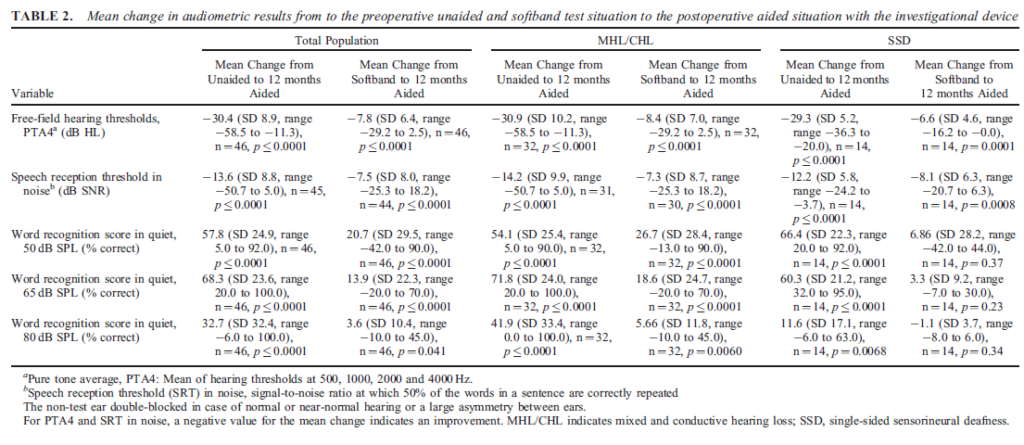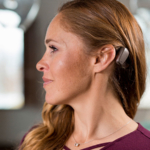Multicenter Clinical Investigation of a New Active Osseointegrated Steady-State Implant System
Emmanuel A. M. Mylanus, Håkan Hua, Stina Wigren, Susan Arndt, Piotr Henryk Skarzynski, Steven A. Telian, and Robert J. S. Briggs
Note: Figures and tables are excerpted from the article.
Purpose
The aim of this international, multicenter study was to demonstrate clinical performance, safety and benefit of the Cochlear™ Osia® System, an active osseointegrated steady-state transcutaneous bone conduction hearing implant system that uses piezoelectric technology.
Key messages
The Osia® System provided excellent functional audiological gain, improved audibility for high frequencies and significant improvement in speech recognition in noise as compared to pre-operative aided testing with a Baha® Softband solution for recipients presenting with conductive-mixed hearing loss and single sided deafness. Additionally, benefit with the Osia System was demonstrated in significantly positive patient-reported outcomes for hearing in real-life situations, wearing comfort and considerable daily use of the system. The surgery was straightforward with a low complication rate.
Methods3
This was a Cochlear sponsored, global, multicenter prospective within-subject clinical investigation of the first generation of the Cochlear Osia System (Cochlear Bone Anchored Solutions, Sweden).
The first generation Osia System as shown in Figure 1 consists of an implant (OSI100 Implant) with a piezoelectric transducer and a receiver stimulator, receiving coil and retention magnet that is placed under the skin. The OSI100 implant is fixed to the temporal bone with an osseointegrated implant (BI300 Implant, 3mm or 4mm). The external sound processor houses a corresponding retention magnet, which keeps the sound processor magnetically retained on the skin in place, aligning the transmitting and receiving coils. The signal captured by the sound processor is transmitted over a digital link along with power to the internal receiver stimulator package which then transfers the amplified signal to the internal piezoelectric transducer for sound stimulation.
The implantable transducer of the Osia implant is designed for an under-the-skin application. The piezoelectric material in the transducer bends when an electrical current is applied causing a vibration. Attached to the piezoelectric material are counterweights which provide momentum to the vibrations to help amplify the signal. The transducer (noted as “actuator” in the Figure 1 caption) is contained in a titanium housing in the OSI100 implant.

Adult patients who 1) presented with either conductive hearing loss or mixed hearing loss with upper limit for bone conduction threshold of 55 dB HL or single-sided deafness with air conduction threshold pure tone average of 20 dB HL or better in the better ear, 2) trialed a bone conduction transducer on a soft band prior to surgical intervention and 3) chose to receive the Osia device were included in the study.
The surgical outcome measures included soft tissue thickness, soft tissue thinning at the location of the sound processor, surgery time, bone polishing/removal at the actuator site, type/location of surgical incision and surgical complications.
Audiological outcome measures were conducted pre-operatively unaided and using a Cochlear Baha BP110 Power sound processor on a Baha Softband. Post-operative assessments were performed with the implanted device at activation which was four weeks post-op as well as at six weeks post-op, three months post-op, six months post-op and 12 months post-op. Pure tone average (0.5, 1, 2, and 4 kHz), speech recognition (monosyllabic words) in quiet, and speech recognition thresholds (SRT) in noise were analyzed for performance with the implanted device compared to pre-op scores.
Patient-reported outcomes were measured on three validated questionnaires. The first was the Health Utilities Index (HUI3) which evaluates eight health-related quality of life dimensions (vision, hearing, speech, walking/mobility, dexterity, self-care, emotion, cognition) and a comprehensive health state attribute. The subject assigned a score to their health status in the various dimensions.
The second was the Abbreviated Profile of Hearing Aid Benefit (APHAB), which is a hearing-related instrument where subjects report the amount of trouble they are having with communication or noise in everyday situations. The ratings are categorized into four subscales (ease of communication, reverberation, background noise, aversiveness) and a global score. Benefit is calculated by comparing difficulty in the unaided condition with their amount of difficulty when using amplification.
The third questionnaire was the Speech, Spatial and Qualities of Hearing Scale (SSQ12), a shorter version of the original 49-item SSQ questionnaire. It measures ratings of hearing disability in the subject’s everyday life across three subdomains (speech, spatial and qualities of hearing). In addition to the questionnaires, daily usage and a comfort rating were collected.
Results3
Fifty-one adult subjects with mixed hearing loss (n=23), conductive hearing loss (n=14) and single-sided sensorineural deafness (n=14) were implanted with the Osia device. Two were implanted bilaterally.
The first generation Osia device was surgically implanted following the procedure described in the physician’s guide provided by the manufacturer. The average length of surgery was 97.2 minutes. Ten subjects had skin flap reduction at surgery, which was mandated if the skin flap was measured at greater than 6mm. The majority of subjects (42) required bone polishing at the site of the BI300 and underneath the transducer. The surgical incisions used were C-shaped (n=30), S-shaped (n=19), curvilinear C-shaped (n=1) and anterior slightly curved (n=1). No unexpected problems arose in surgery, however there was one serious adverse event that occurred post-operatively. A wound infection developed into skin necrosis and dehiscence leading to explantation at 55 days post-op despite medical and surgical treatment.
Results were reported for 12 months post-op compared to pre-op unaided and aided testing with the BP110 on a Softband. For all subjects, there was significant improvement of 30.4 dB from unaided and 7.8 dB from Softband for pure tone average. High frequency thresholds were notably improved with the Osia device. Results are shown in Figure 3. Speech reception threshold (SRT) in noise (the signal-to-noise ratio at which 50% of the words in a sentence are correctly repeated) improved by 13.6 dB compared to unaided and 7.5 dB compared to softband. For word recognition in quiet, there was no difference with the implanted device for subjects with single sided deafness (SSD), however performance was significantly improved for the subjects with mixed and conductive hearing loss (CHL/MHL). At a soft speech level (50 dB), CHL/MHL subjects scored 26.7% better than with the Softband. When tested at conversational levels (65 dB), CHL/MHL subjects had a 18.6% improvement over the Softband. Results are shown in Table 2.


Results on the three patient questionnaires were reported for all subjects and for the subgroups CHL/MHL and SSD. All patient reported outcomes demonstrated statistically significant improvements post-operatively with the implanted device. The HUI3 showed significant improvement in both the hearing and speech dimensions for all subjects and for the CHL/MHL subgroup. However, the difference between pre- and post-op was not statistically significant in the SSD subgroup. On the APHAB, the global score and all subscales except aversiveness demonstrated significant improvements for all subjects and for both subgroups. Finally, all SSQ12 subdomains were significantly improved for all subjects and for both subgroups. Results are shown in Table 3.

Daily use of the sound processor was also captured. The average for all subjects was 11.3 hours per day. There was a difference in daily wear when looking at the subgroups, with 12.2 average hours per day for CHL/MHL and 9.3 average hours per day for SSD.
Comfort was assessed using a visual analog scale (0% no comfort, 100% most comfortable). The average comfort level was 80.9% for all subjects, 79.7% for CHL/MHL, and 83.9% for SSD.
Conclusion
The surgical analysis revealed no intraoperative surgical complications and while there was one serious post-operative complication (explantation following an infection shortly after surgery), overall, there was a low rate of post-operative complications. The main surgical consideration by the authors was that a certain amount of bone polishing was performed in most subjects to create a flat bone surface underneath the actuator. However, the amount of bone removal for the Osia implant’s piezoelectric transducer was less than the relatively large amount of bone removal needed to accommodate an electromagnetic transducer, which reduces surgical challenges and/or anatomical restrictions. The Osia System can be implanted in patients with limited bone thickness and does not require significant volumes of bone to be removed.
Hearing performance improvements were statistically significant and clinically relevant demonstrating even greater outcomes over the unaided condition with the Osia, an active transcutaneous system implanted directly on the bone, than with a passive transcutaneous system that transmits sound vibrations across the skin from an externally housed actuator. The difference in audibility with the Osia was greatest for the high frequencies in both subgroups. In the SSD subgroup, the Osia was able to compensate for transcranial attenuation, especially in the high frequencies. This improved access to high frequency sounds is important for speech discrimination, especially in noise as demonstrated in improved SRT signal-to-noise ratio for both subgroups.
Additional benefits were found on quality of life questionnaires. Real-life hearing situations were reported to be improved with use of the Osia and there was a significant decrease in hearing disability post-op. These betterments may positively impact social, emotional and communication dysfunctions caused by hearing impairment. A further subjective benefit was seen for the SSD group on spatial hearing ability with acoustic information provided by the implanted device to the better hearing ear.
Patient acceptance of the Osia device by all subjects was very good as suggested by the high average daily use and reported level of comfort. The hours per day are higher than reports of passive transcutaneous systems.1-2 This increase in wear time is likely due to the improved cosmetics and comfort of wearing the device. This is also shown in the lack of increase in aversiveness, which relates to discomfort with use or wearing, in the subjective reports on the APHAB.
There are demonstrated benefits of the piezoelectric transducer in the first generation Osia System, representing technological advancement in bone conduction implants. The piezoelectric transducer has high power output, especially in the high frequencies, to provide optimal speech perception and high levels of patient satisfaction. The safety analyses up to and including 12 months of follow-up suggest that the system is safe and performs as intended.
To learn more about the Osia System, subscribe to Cochlear ProNews or watch this webinar series.
References:
- den Besten CA, Monksfield P, Bosman A, et al. Audiological and clinical outcomes of a transcutaneous bone conduction hearing implant: six-month results from a multicentre study. Clin Otolaryngol 2019;44:144–57.
- Briggs R, Van Hasselt A, Luntz M, et al. Clinical performance of a new magnetic bone conduction hearing implant system: results from a prospective, multicenter, clinical investigation. Otol Neurotol 2015;36:834–41.
Citation:
- Mylanus, Emmanuel A. M.; Hua, Håkan; Wigren, Stina; Arndt, Susan; Skarzynski, Piotr Henryk; Telian, Steven A.; Briggs, Robert J. S. Multicenter Clinical Investigation of a New Active Osseointegrated Steady-State Implant System, Otology & Neurotology: August 17, 2020 – Volume Publish Ahead of Print – Issue -doi: 10.1097/MAO.0000000000002794
Authors & Affiliations:
Emmanuel A. M. Mylanus – Department of Otorhinolaryngology, Donders Center for Neurosciences, Radboud university medical center, Nijmegen, The Netherlands
Håkan Hua; Stina Wigren – Cochlear Bone Anchored Solutions AB, Mölnlycke, Sweden
Susan Arndt – Department of Oto-Rhino-Laryngology and Implant Center, Medical Center – University of Freiburg, Germany
Piotr Henryk Skarzynski – Department of Teleaudiology and Screening, World Hearing Center, Institute of Physiology and Pathology of Hearing, Kajetany, Poland
Steven A. Telian – John L. Kemink Professor of Neurotology, University of Michigan, Ann Arbor, Michigan
Robert J. S. Briggs -The University of Melbourne Department of Surgery, Otolaryngology, The Royal Victorian Eye and Ear Hospital, Australia
This blog is intended to serve as a resource for clinicians to help keep up to date with current clinical literature and is intended for professionals only. Clinical literature is based on research, which may include the experimental use of new or currently available products and technologies. Therefore, literature presented on Cochlear ProNews may represent use of Cochlear products that does not align with the intended use or indications approved by regulatory bodies, also known as off-label use. Cochlear does not condone any off-label use of its products, and it is not Cochlear’s intent to promote off-label use by providing this blog as a resource to clinicians.
This content is meant for professional use. If you are a consumer, please seek advice from your health professional about treatments for hearing loss. Outcomes may vary, and your health professional will advise you about the factors which could affect your outcome. Always read the instructions for use. Not all products are available in all countries. Please contact your local Cochlear representative for product information. Views expressed are those of the individual. Consult your health professional to determine if you are a candidate for Cochlear technology.
In the United States, the Osia 2 System is cleared for children 12 and older. In the United States and Canada, the placement of a bone conduction implant is contraindicated in Children under the age of 5.


